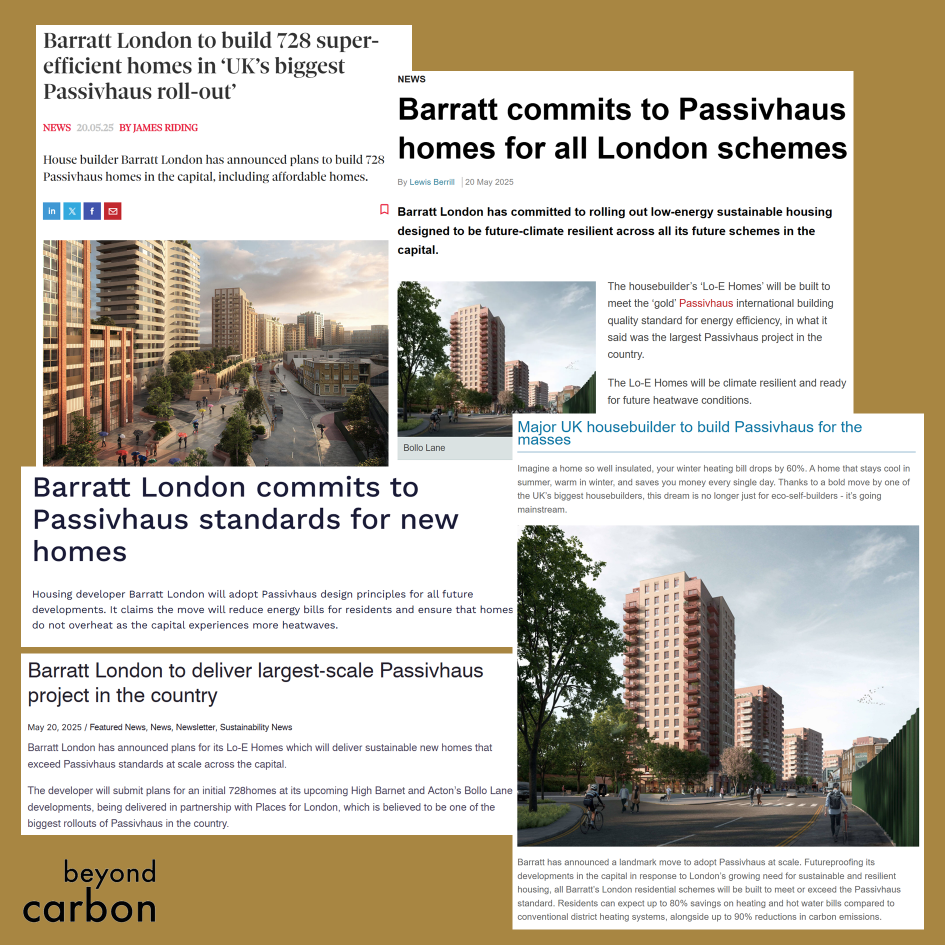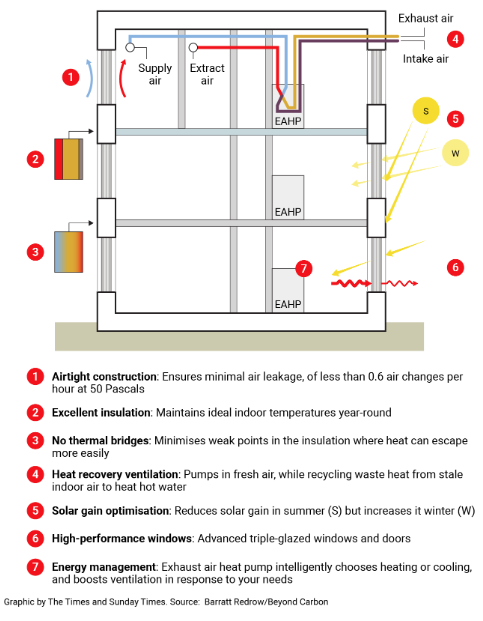Barratt London commits to Passivhaus for all London developments
We're really proud to share some exciting news today as Barratt London publicly announces its commitment to build and certify all new London homes to the Passivhaus standard.
Beyond Carbon has worked closely with Barratt for almost two years to develop their approach to Passivhaus for London multi-residential. The homes will be certified to Passivhaus, which Barratt is calling their ‘Lo-E Homes’, proving that Passivhaus can deliver low-energy homes that keep occupants warm in wintertime and safe in heatwave conditions, whilst being low cost to run.
Barratt’s announcement has been extensively covered in both national and trade press, including this article in The Times (19th May). Multiple trade press publications also led with the news, reaching more than 13 million readers and subscribers across 27 trade press publications.
Press cuttings of Lo-E Homes launch
In The Times article, our founding director Dr Joel Callow outlines the approach taken to achieve 'fine-tuned, precision low-energy homes', delivering Passivhaus with exhaust air heat pumps - which can provide air tempering in summer to mitigate overheating in heatwaves - and without the requirement to connect to district heating systems. Tuning at design stage proved vital: "You discover some things are worth improving (such as window design, self-shading and thermal performance), while other things are already good enough (e.g. wall U-value, which often need not exceed current practice)."
The Barratt Lo-E solution utilises the Passivhaus approach to design:
👉 Optimised windows (reduce heat loss, minimise excessive solar gain, provide optimal daylight)
👉 Heat pumps that provide heating, heat recovery, ventilation, hot water and cooling
👉 Standard insulation (upgraded insulation not required due to excellent form-factor)
👉 Super airtightness
👉 Thermal bridge free design
The key principles to deliver Passivhaus for the Lo-E Homes standard
Joel explains why this is a game-changing commitment for the UK housing industry: “The conceptualisation of Lo-E Homes by Barratt London is ahead of the curve and an exemplar project, and considers current and proposed future legislation, ensuring the homes are futureproofed long before the first spade is in the ground. There is currently no firm commitment from any other volume housebuilders, that we are aware of, to deliver certified Passivhaus at scale. Barratt London is pushing the sustainability envelope as a genuine leader, paving the way for volume housebuilders to address future housing needs and demonstrating innovation in the sector. London is set to be a hub of Passivhaus excellence, with Lo-E Homes playing a significant role. In simple terms, thanks to the gold-standard Passivhaus specification, they’re as good as it gets.”
Craig Carson, Managing Director at Barratt West London, is quoted as saying: “Our Lo-E Homes are an opportunity to think differently and deliver a new approach to high-density, sustainable housing in London. This is a significant milestone for the business, as we look to the future and consider the unique challenges faced in the capital, such as more heatwave conditions every few years. Feedback from local councils and the GLA has been supportive, so we look forward to securing planning approval and moving ahead with our first homes, before rolling out across future developments over the next few years. The first Lo-E Homes will be unveiled across two significant partnership sites – High Barnet and Bollo Lane, as part of the West London Partnership with Places for London.”
Congratulations to all involved, this is an incredible milestone, marking a step-change in the approach to new build homes at scale.
Contact us if you’d like more information about using the Passivhaus standard on large-scale multi-residential schemes.


